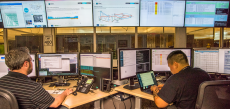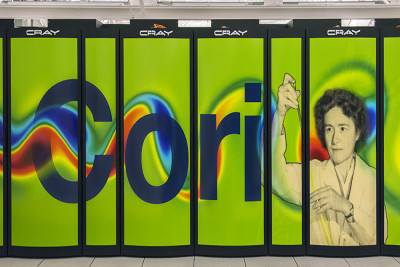NERSC, ESnet Continue to Deliver Supercomputing, Networking Support for Nation’s Scientists During Pandemic
April 1, 2020
Written by Jon Bashor
Contact: CS Communications

Operations staff monitor NERSC supercomputers and ESnet's high-speed science network from the control room at Berkeley Lab. (Photo by Marilyn Chung, Berkeley Lab)
While people around the world hunker down in their homes to try to slow the advance of the COVID-19 virus and many services have decreased or stopped, two user facilities operated by the U.S. Department of Energy’s Office of Science continue to provide critical computing and networking resources to thousands of scientists, including some who are exploring ways to fight the pandemic.
The National Energy Research Scientific Computing Center (NERSC) and the Energy Sciences Network (ESnet) are managed by Lawrence Berkeley National Laboratory, which has reduced operations and onsite staffing under state-wide shelter-in-place orders. But NERSC and ESnet, deemed to provide essential services to the nation, continue to support “science as usual” as staff remotely manage the facilities from their homes.
NERSC has been named to the COVID-19 High Performance Computing Consortium. Led by the White House Office of Science and Technology Policy, industrial partners, and DOE, the consortium will give researchers access to supercomputers at DOE’s Argonne, Lawrence Livermore, Los Alamos, Oak Ridge, and Sandia national laboratories. ESnet will provide robust, high-bandwidth connections and peerings allowing scientists to tap into these computing resources and move data from across the world to those sites for analysis.
With an eye on pandemic-related research, NERSC staff have set up dedicated priority queues to run COVID-19-related research projects on a supercomputer. In one project, scientists at the Beckman Research Institute at the City of Hope are running molecular dynamic simulations that apply to a range of COVID-19 research areas. In particular, they are looking at the difference between the Chinese and Italian strains of the virus as well as potential antiviral treatments.
“It’s very challenging for everyone, it’s unprecedented,” said NERSC Division Director Sudip Dosanjh. “Our staff are very dedicated, and I think this also shows their passion for the science mission of NERSC, ESnet, and the laboratory.”

NERSC's Cori Supercomputer. (Photo by Roy Kaltschmidt, Berkeley Lab)
In fact, shelter-in-place policies across the country appear to be fostering even greater demands on the supercomputers at NERSC. With travel plans and conferences delayed or canceled, many of NERSC’s more than 7,000 users are spending their time at home but still want to advance their research by running projects on the center’s systems, Dosanjh surmised.
“Thanks to the dedicated efforts of NERSC personnel to keep computing systems running and supporting users’ requests, our ‘computing lab’ (NERSC) remains open and operational at full capacity," said Manos Mavrikakis, a NERSC user and distinguished professor at the University of Wisconsin-Madison whose work focuses on understanding catalytic process principles and the discovery of new materials that would enable more efficient energy production. "As a result, we have been able to continue pursuing our research on catalytic reaction mechanisms, pretty much at the same pace as before coronavirus dominated everybody’s lifestyle. We are enormously grateful to NERSC personnel for an excellent job under highly stressful conditions.”
“We recognize the importance of that and are seeing that the utilization of Cori, our primary computer, is at 97 percent, an all-time high,” Dosanjh said. “A lot of other people can’t do their work unless we do our job, and I couldn’t be more proud of our staff.”
Cori, a Cray XC40 supercomputer able to perform nearly 30 quadrillion calculations per second, is used to create detailed models of scientific problems and analyze massive amounts of data from experimental facilities operated by DOE.

Energy Sciences Network
ESnet provides the critical high-bandwidth connection between tens of thousands of researchers at national labs, universities, user facilities and supercomputer centers like NERSC. ESnet operates a dedicated multi-100-gigabits-per-second network that crisscrosses the country and has four similar links crossing the Atlantic Ocean for collaborations in Europe. Almost all network traffic passing to and from DOE laboratories traverses the network.
Although ESnet’s operations center is in Berkeley, about 40 percent of the staff live in other states across four time zones and are used to working offsite. The network operates 24 hours a day, 365 days a year, enabling scientists to seamlessly access data portals, transfer massive research data sets, and tap into remote scientific instruments — all in real-time from anywhere.
The dispersed staff are both closer to other facilities and bring different perspectives to solving network issues, said Tony Ferrelli, head of ESnet’s Network Engineering and Operations Team. With so many people across the country working from home, ESnet has seen a blip in traffic moving onto the network, Ferrelli said, but there is still bandwidth to spare. One interesting note is that with more people working from home, they are finding that their home network connections are much slower than expected, which is compounded by increased demand, Ferrelli said.
Network staff is also on hand to help researchers should they need help to manage the large datasets that are typical of DOE science, ESnet Director Inder Monga said.
“It’s all about the people - those of us whose job is to provide these resources and those who tap into them to support our nation’s scientific leadership,” Monga said. “With all these efforts, science is proceeding as usual.”
By connecting with other research and education networks, ESnet is providing a critical link for scientists and consortium members like those from COVID-19 High Performance Computing Consortium with DOE supercomputer centers, thereby supporting research efforts into the COVID-19 pandemic.
About Computing Sciences at Berkeley Lab
High performance computing plays a critical role in scientific discovery. Researchers increasingly rely on advances in computer science, mathematics, computational science, data science, and large-scale computing and networking to increase our understanding of ourselves, our planet, and our universe. Berkeley Lab’s Computing Sciences Area researches, develops, and deploys new foundations, tools, and technologies to meet these needs and to advance research across a broad range of scientific disciplines.







 Instagram
Instagram YouTube
YouTube